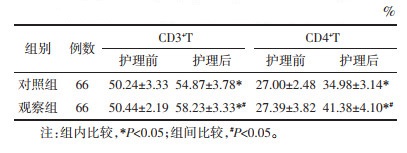文章信息
- 张金梅, 周国均, 刘莹莹
- ZHANG Jinmei, ZHOU Guojun, LIU Yingying
- 温针灸护理路径对肺癌手术患者快速康复的促进效果
- Effects of warm acupuncture nursing path on the rapid rehabilitation of patients with lung cancer surgery
- 天津中医药, 2021, 38(5): 638-641
- Tianjin Journal of Traditional Chinese Medicine, 2021, 38(5): 638-641
- http://dx.doi.org/10.11656/j.issn.1672-1519.2021.05.20
-
文章历史
- 收稿日期: 2020-12-25
2. 十堰市太和医院输血科, 十堰 442000
肺癌是呼吸系统常见的肿瘤,也是世界范围内病死率居首位的恶性肿瘤,当前在中国的发病率逐年上升[1]。早期肺癌患者采用手术治疗能取得比较好的效果,能显著延长患者的生存时间[2-3]。目前肺癌手术患者的快速康复方法主要为宣教及心理疏导、呼吸功能训练、早期下床活动等,虽然有一定的效果,但是应用随意性比较强,执行上也存在一定的偏差[4-5]。当前中医广泛应用于肿瘤患者的术后护理,其中温针灸具有便于操作、不良反应小、安全经济、疗效确切等特点,在临床上的应用取得了比较好的效果,但缺乏统一规范的研究方案[6-7]。其能采用生物热效应及非热效应,通过一系列的生化、免疫、生理等方面的调整来改善人体的功能[8-9]。文章具体探讨了温针灸护理路径对肺癌手术患者快速康复的促进效果,希望具有重要的实用价值和现实意义。现总结报道如下。
1 资料与方法 1.1 研究对象本研究得到了本院伦理委员会的批准。2016年2月到2019年5月选择在本院诊治的早期肺癌患者132例,纳入标准:经临床、影像学或内镜及病理确诊为非小细胞肺癌患者;临床分期为Ⅰ~Ⅱ期,具有可手术切除的指征,且顺利完成手术;术前均未接受放疗或化疗;无肺门和纵膈淋巴结转移;患者年龄30~70岁,签署了知情同意书。排除标准:阴虚患者;因认知障碍不能配合护理干预及观察者;肺部良性病变患者;药物和酒精依赖史患者;妊娠或者哺乳期患者;患有自身免疫性疾病患者。
根据随机数字表法把患者分为观察组与对照组各66例,两组患者的性别、年龄、临床分期、医疗费用支付方式、病变部位、受教育年限、婚姻状况等对比差异无统计学意义(P > 0.05),具有可比性。见表 1。
对照组:给予传统护理,主要包括入院宣教、呼吸功能锻炼、镇痛管理、术后早期下床活动等。观察组:在对照组护理的基础上给予术后温针灸护理路径干预,具体措施如下:1)取患者的三阴交、关元、足三里、合谷等穴位,选择3年陈艾纯艾条(南阳汉医艾条厂),规格为18 mm×200 mm,将艾条切段备温针灸用,每段约(25±3) mm。2)根据患者选择穴位,将毫针刺入,使用提插平补平泻法刺激2~3 min,再将针尾1.5 cm艾条点燃,选择有孔端点燃艾条,套入针柄2/3使艾条能竖立愈针柄上,艾条燃完后将针取出,每天1次,每周星期一、三、五进行1次操作,如患者感觉烧烫难忍则加垫硬纸片隔热防护。
两组术后护理观察时间为30 d。
1.3 观察指标1) 两组在护理前后采用焦虑自评量表(SAS)与抑郁自评量表(SDS)评定患者的心理状况,SAS与SDS标准分的分界值为50分,分数越高,心理状况越差[1]。2)在护理前后抽取患者的静脉血3~5 mL,采用免疫荧光法检测T淋巴细胞亚群和NK细胞活性,试剂盒由上海生工公司提供,所有操作严格按照试剂盒说明书进行。3)护理满意度调查采用的是北京协和医学研制的住院患者护理工作满意度调查量表进行判定[5]。4)在护理后采用《症状自评量表SCL90》评定患者的生活质量,分数越高,生活质量越差。
1.4 统计学方法选择SPSS24.00软件对所有数据进行分析与处理,计量数据以均数±标准差(x±s)表示,计量资料组内治疗前后比较采用配对t检验,组间比较采用独立样本t检验;计数资料以构成比或率表示,组间比较采用χ2检验。检验水准α=0.05。
2 结果 2.1 焦虑与抑郁评分对比两组护理后的焦虑与抑郁评分都显著低于护理前(P < 0.05),观察组也低于对照组(P < 0.05),差异具有统计学意义。见表 2。

|
两组护理后的CD3+ T、CD4+ T淋巴细胞比例都显著高于护理前(P < 0.05),观察组也高于对照组(P < 0.05),差异具有统计学意义。见表 3。

|
观察组对于住院期间的护理满意度为100.0%,显著高于对照组的90.9%(P < 0.05),差异具有统计学意义。见表 4。
观察组护理后的SCL-90生活质量各维度评分都显著低于对照组(P < 0.05),差异具有统计学意义。见表 5。

|
伴随社会老龄化、吸烟人数增多与环境污染等,中国每年肺癌的发病率仍呈上升趋势。虽然随着医学技术的发展,手术治疗极大提高了该病的治疗有效率,但由于肺癌具有极高的恶性程度,所以很多患者术后生活质量比较低[10-11]。
本研究显示两组护理后的焦虑与抑郁评分都显著低于护理前(P < 0.05),观察组也低于对照组(P < 0.05);观察组对于住院期间的护理满意度为100.0%,显著高于对照组的90.9%(P < 0.05),表明温针灸护理路径能促进缓解患者的焦虑与抑郁症状,提高患者的满意度。抑郁是一种以心境低落为主要特点的情绪反应,焦虑是一种预期的危险情境中引发的紧张不愉快的情绪反应。肺癌术后患者多数存在明显的焦虑、抑郁情绪,有研究显示在肺癌诊断时大约33.3%的患者被报道有抑郁情绪,25.0%左右的患者患有严重抑郁[12-14]。恰当的护理干预可有效稳定患者情绪,使其以最佳心理状态接受治疗,减少患者心理应激,改善其心理痛[15]。温针灸通过艾火刺激作用于人体特定的穴位,升高皮肤内外的温度,促进机体神经功能的恢复,减轻患者因手术及疾病所带来的不适以达到治病防病目的。特别是温针灸在护理过程中由于热传导效应,可使患者感到舒适,促进了血液、淋巴液在体内的循环,有利于调整人体的代谢过程,从而改善患者的身心状况[16]。
本研究显示两组护理后的CD3+、CD4+ T淋巴细胞比例都显著高于护理前(P < 0.05),观察组也高于对照组(P < 0.05),表明温针灸护理路径可提高机体的免疫力。温针灸是中医重要的组成部分,是温热刺激、光谱辐射、艾燃烧生成物的成分及作用,可增强人体免疫力,双向调节人体神经内分泌、消化、呼吸、循环等系统功能的功效[17]。关元补肾培元,通调冲任。三阴交为足三阴经交会穴,能补脾胃、益肝肾、调气血。足三里、合谷乃肝之背俞穴,有疏肝理气之作用。T细胞亚群为机体细胞免疫的第一道防线,CD3+ T、CD4+ T细胞亚群具有各自的作用,其中CD3+ T细胞亚群具有杀伤肿瘤细胞作用,可参与激活细胞毒T细胞、巨噬细胞、B细胞;CD4+ T具有降低肿瘤细胞免疫逃避效果[18]。同时在护理中不能忽略家属的作用,通过家属的参与和配合,使患者积极地配合各种治疗,促进保持良好的心理状态,树立战胜肿瘤的信心,从而有利于改善自身的免疫功能[19-20]。
随着健康观念的改变,肺癌患者手术治疗和护理的目的不单纯是为了延长生命,还需要提高患者的生活质量[21]。本研究显示观察组护理后的SCL-90生活质量各维度评分都显著低于对照组(P < 0.05),表明温针灸护理路径能提高患者的生活质量。
总之,温针灸护理路径在肺癌手术患者中的应用能促使患者快速康复,缓解焦虑抑郁情绪,改善机体的免疫功能,提高护理满意度与生活质量。
| [1] |
DEOL P S, SIPKO J, KUMAR A, et al. Effect of insurance type on perioperative outcomes after robotic-assisted pulmonary lobectomy for lung cancer[J]. Surgery, 2019, 166(2): 211-217. DOI:10.1016/j.surg.2019.04.008 |
| [2] |
FAHIM C, HYLTON D, SIMUNOVIC M, et al. Development of the IRIS-AR strategy: an intervention to improve rates of accrual and retention for the VTE-PRO randomized controlled trial[J]. Trials, 2019, 20(1): 447. DOI:10.1186/s13063-019-3536-8 |
| [3] |
GILBERTSON-WHITE S, PERKHOUNKOVA Y, SAEIDZADEH S, et al. Understanding symptom burden in patients with advanced cancer living in rural areas[J]. Oncology Nursing Society, 2019, 46(4): 428-441. |
| [4] |
HU X L, XU S T, WANG X C, et al. Development and validation of nomogram estimating post-surgery hospital stay of lung cancer patients: relevance for predictive, preventive, and personalized healthcare strategies[J]. EPMA Journal, 2019, 10(2): 173-183. DOI:10.1007/s13167-019-00168-z |
| [5] |
HUANG K L, WANG S Y, LU W C, et al. Effects of low-dose computed tomography on lung cancer screening: a systematic review, meta-analysis, and trial sequential analysis[J]. BMC Pulmonary Medicine, 2019, 19(1): 126. DOI:10.1186/s12890-019-0883-x |
| [6] |
邓德宏, 张春文. 观察中药泡洗、针灸、推拿联合康复训练对脑梗塞后肩手综合征患者的生活质量[J]. 系统医学, 2019, 4(6): 154-156. DENG D H, ZHANG C W. Observation on the quality of life of patients with shoulder-hand syn-drome after cerebral infarction by traditional chinese medicine bubble washing, acupuncture and massage combined with rehabilitation training[J]. Systems Medicine, 2019, 4(6): 154-156. |
| [7] |
骆劲超, 傅红明, 陈慧, 等. 不同温针灸量联合中药治疗膝骨关节炎临床研究[J]. 上海针灸杂志, 2019, 38(6): 654-659. LUO J C, FU H M, CHEN H, et al. Clinical study on different intensities of warm needling moxibustion plus chinese herbal medicine for treatment of knee osteoarthritis[J]. Shanghai Journal of Acupuncture and Moxibustion, 2019, 38(6): 654-659. |
| [8] |
郑娟, 张盛. 醒脑开窍法治疗急性脑梗死患者对其炎性反应递质、神经功能及超早期脑氧代谢的影响[J]. 世界中医药, 2019, 14(5): 1294-1297. ZHENG J, ZHANG S. Effect of Xingnao Kaiqiao Therapy on inflammatory response transtransmitters, neurological function and ultra-early cerebral oxygen metabolism in patients with acute cerebral infarction[J]. World Chinese Medicine, 2019, 14(5): 1294-1297. DOI:10.3969/j.issn.1673-7202.2019.05.051 |
| [9] |
IGAWA S, ONO T, KASAJIMA M, et al. Impact of EGFR genotype on the efficacy of osimertinib in EGFR tyrosine kinase inhibitor-resistant patients with non-small cell lung cancer: a prospective observational study[J]. Cancer Management and Research, 2019, 11: 4883-4892. DOI:10.2147/CMAR.S207170 |
| [10] |
LEHTO R H. Active smoking at the time of a lung cancer diagnosis[J]. Asia-Pacific Journal of Oncology Nursing, 2019, 6(3): 207-208. DOI:10.4103/apjon.apjon_12_19 |
| [11] |
QUINONES A R, BOTOSENEANU A, MARKWARDT S, et al. Racial/ethnic differences in multimorbidity development and chronic disease accumulation for middle-aged adults[J]. PLoS One, 2019, 14(6): e0218462. DOI:10.1371/journal.pone.0218462 |
| [12] |
QUINONES A R, MELEKIN A, CIGOLLE C T, et al. Disputes of self-reported chronic disease over time: the role of race, ethnicity, nativity, and language of interview[J]. Medical Care, 2019, 57(8): 625-632. DOI:10.1097/MLR.0000000000001148 |
| [13] |
SAKTIAWATI A M I, STIENSTRA Y, SUBRONTO Y W, et al. Sensitivity and specificity of an electronic nose in diagnosing pulmonary tuberculosis among patients with suspected tuberculosis[J]. PLoS One, 2019, 14(6): e0217963. DOI:10.1371/journal.pone.0217963 |
| [14] |
SUN V, RAZ D J, ERHUNMWUNSEE L, et al. Improving family caregiver and patient outcomes in lung cancer surgery: Study protocol for a randomized trial of the multimedia self-management (MSM) intervention[J]. Contemporary Clinical Trials, 2019, 83(3): 88-96. |
| [15] |
WANG Y Q, LIU X, YIN Y Y, et al. Effects of home-based exercise training for patients with lung cancer[J]. Oncology Nursing Forum, 2019, 46(4): e119-e134. |
| [16] |
李秀双, 付于, 于建春, 等. 韩景献教授治疗肺癌术后淋巴水肿医案[J]. 天津中医药, 2017, 34(5): 356-357. LI X S, FU Y, YU J C, et al. The case of postoperative lung cancer lymphedema treated by Professor HAN Jingxian[J]. Tianjin Journal of Traditional Chinese Medicine, 2017, 34(5): 356-357. |
| [17] |
殷高政, 马学真. 温针灸对非小细胞肺癌患者免疫功能的影响[J]. 光明中医, 2017, 32(17): 2538-2539. YIN G Z, MA X Z. The effect of warming acupuncture and moxibustion on immune function of patients with non-small cell lung cancer[J]. Guangming Journal of Chinese Medicine, 2017, 32(17): 2538-2539. DOI:10.3969/j.issn.1003-8914.2017.17.041 |
| [18] |
孙怡, 周竞, 郭娅静, 等. 隔药灸对肿瘤坏死因子-α介导克罗恩病肠上皮细胞凋亡途径的影响[J]. 针刺研究, 2019, 44(1): 1-7. SUN Y, ZHOU J, GUO Y J, et al. Effect of drug isolation moxibustion on tumor necrosis factor-α mediated apoptosis pathway of intestinal epithelial cells in Crohn's disease[J]. Acupuncture Research, 2019, 44(1): 1-7. |
| [19] |
HUNG M S, WU Y F, CHEN Y C. Efficacy of chemoradiotherapy versus radiation alone in patients with inoperable locally advanced non-small-cell lung cancer: A meta-analysis and systematic review[J]. Medicine (Baltimore), 2019, 98(27): e16167. DOI:10.1097/MD.0000000000016167 |
| [20] |
HUO J, BIAN J, XIE Z, et al. Patterns of postdiagnosis depression among late-stage cancer patients: do racial/ethnic and sex disparities exist?[J]. American Journal of Clinical Oncology-Cancer Clinical Trials, 2019, 42(8): 675-681. |
| [21] |
HUANG T H, WU T H, GUO Y H, et al. The concurrent treatment of Scutellaria baicalensis Georgi enhances the therapeutic efficacy of cisplatin but also attenuates chemotherapy-induced cachexia and acute kidney injury[J]. Journal of Ethnopharmacology, 2019, 243(6): 112075. |
2. Department of Transfusions, Affiliated Taihe Hospital of Shiyan City, Shiyan 442000, China
 2021, Vol. 38
2021, Vol. 38






